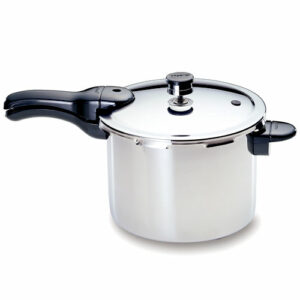[/caption]
The other day I received the following comment from MeITX. regarding my post The Many Amazing Uses of a Pressure Cooker as a Tool for Preppers. It stated, “Don’t confuse a pressure canner with a pressure cooker. It is my understanding that you can cook AND can in a pressure canner but you cannot can in a pressure cooker. Not trying to mince words but I’ve been taught that the difference is important”
I love getting comments like this because I learn from them. As a result of this comment, I have done some research on pressure cookers vs pressure canners and MeITX is right. You have to beware of using many of the pressure cookers for canning. A pressure canner can be used as a pressure cooker, but the reverse is not always true.
When I was younger we used what I always thought of as a pressure cooker for canning, I made a bad assumption that pressure canners and cookers could be used interchangeable. Many of the newer pressure cookers are electric and there have been many design changes.
As you probably know, for low acid foods you have to have 15 lbs of pressure; this lets you achieve temperatures of 250° F. This is what is required to kill botulism spores.
Pressure cookers are designed to rapidly cook meats, vegetables and other foods quickly, but often are not built as heavy as pressure canners. Many of the pressure cookers have the wrong type of relief valve to maintain the pressures required for canning low acid foods.
A source that I have always trusted for canning information is the National Center for Home Food Preservation at the University of Georgia. Here is what they say on this subject.

“USDA does not have recommended processes for canning in a small pressure cooker. The recommendation for using USDA pressure processes for low-acid foods is to use a canner that holds at least four (4) quart-size jars. The research for USDA pressure processes for vegetable and meat products was conducted in pressure canners that are most similar to today’s 16-quart or larger pressure canners.
Pressure cookers have less metal, are smaller in diameter, and will use less water than pressure canners. The result is that the time it takes a canner to come up to processing pressure (that is, the come-up time) and the time it takes the canner to cool naturally down to 0 pounds pressure at the end of the process (known as the cool-down time) will be less than for the standard pressure canner. The come-up and cool-down times are part of the total processing heat that was used to establish USDA process times for low-acid foods. If the heat from the come-up and cool-down periods is reduced because these times are shortened, then the heat from the process time at pressure alone may not be enough to destroy targeted microorganisms for safety. That is, the food may end up underprocessed. Underprocessed low-acid canned foods are unsafe and can result in foodborne illness, including botulism poisoning, if consumed.”
As you can see, they advise you not to use pressure cookers for canning low acid foods. Before you use a pressure cooker for pressure canning, I recommend you check with the manufacturer and follow their recommendations. We have two of the All American pressure canners and use them for both canning and cooking. I can recommend them
If you see something you question in one of my posts don’t hesitate to question it. Whenever you do, I learn something.
Howard


Thanks for the update, but the second photo you included is a pressure cooker, but is labeled a pressure canner in the caption.
Thanks I corrected it.
Howard
This is really good information. I also used this website to learn all about cooking and canning with pressure cookers and which machine to buy. I love my All American!